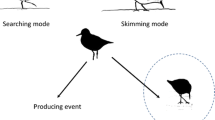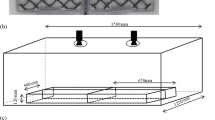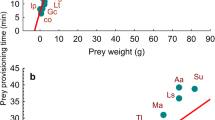Abstract
Group foraging allows the co-existence of a strategy (producer) that involves searching for food, and its alternative (scrounger) exploiting the food of the producer. The use of producer and scrounger strategies has been modelled as an alternative-option scramble which assumes strong negative frequency-dependence of the scrounger's pay-offs. We tested this assumption in a flock feeding situation by manipulating the proportion of scroungers in flocks of spice finches, Lonchura punctulata. In a first experiment we found that: (1) the food intake of scroungers, and to a lesser extent producers, was negatively affected by an increase in the proportion of scroungers; (2) the food intake of producers and scroungers was equal when the proportion of scroungers was small, suggesting that producers, who exploited 35.4% of their patches by scrounging were opportunistically adjusting their use of the strategies until the pay-offs equalized. In a second experiment we tested whether finches could vary their use of the two strategies in response to changes in foraging conditions brought about by an increase in the cost of producing. As predicted by the game, finches reduced their use of the producer strategy and increased their use of the scrounger strategy when the cost of producing increased. These results suggest that spice finches can alter their allocation to each foraging alternative by experience and that the producer-scrounger game is a realistic model for predicting group foraging decisions.
Similar content being viewed by others
References
Barnard CJ (1984) The evolution of food-scrounging strategies within and between species. In: Barnard CJ (ed) Producers and scroungers: strategies of exploitation and parasitism. Chapman and Hall, New York, pp 95–126
Barnard CJ, Sibly RM (1981) Producers and scroungers: a general model and its application to captive flocks of house sparrows. Anim Behav 29:543–550
Brockmann JH, Barnard CJ (1979) Kleptoparasitism in birds. Anim Behav 27:487–514
Caraco T, Giraldeau L-A (1991) Social foraging: Producing and scrounging in a stochastic environment. J Theor Biol 153:559–583
Dawkins, R (1980) Good strategy or evolutionarily stable strategy? In: Barlow GW, Silverberg J (eds) Sociobiology: Beyond Nature/Nurture? AAA S Selected Symposium 35, Westview Press, Boulder, pp 331–367
Ennis N (1992) Do flocks of specialists forage more efficiently than flocks of generalists: a test of the skill pool hypothesis using flocks of spice finches Lonchura punctulata. Unpublished MSc thesis, Concordia University, Montreal
Giraldeau L-A, Lefebvre L (1986) Exchangeable producer and scrounger roles in a captive flock of feral pigeons: a case for the skill pool effect. Anim Behav 34:797–803
Giraldeau L-A, Hogan JA, Clinchy MJ (1990) The payoffs to producing and scrounging: what happens when patches are divisible? Ethology 85:132–146
Goodwin D (1982) Estrildid finches of the world. Oxford University Press, Oxford
Hake M, Ekman J (1988) Finding and sharing depletable patches: when group foraging decreases intake rates. Ornis Scand 19:275–279
Harley C (1981) Learning the evolutionarily stable strategy. J Theor Biol 89:611–633
Immelmann K (1982) Australian finches in bush and aviary, 3rd edn. Angus and Robertson, London
Packer C, Ruttan L (1988) The evolution of cooperative hunting. Am Nat 132:159–198
Parker GA (1984a) Evolutionarily stable strategies. In: Krebs JR, Davies NB (eds) Behavioural ecology: an evolutionary approach, 2nd edn. Sinauer, Sunderland, pp 30–61
Parker GA (1984b) The producer/scrounger model and its relevance to sexuality. In: Barnard CJ (ed) Producers and scroungers: strategies of exploitation and parasitism. Chapman and Hall, New York, pp 127–153
Pitcher TJ (1986) Functions of schoaling behaviour in teleosts. In: Pitcher TJ (ed) The behaviour of teleost fishes. Croom Helm, London, pp 294–337
Pöysä H (1992) Group foraging in patchy environments: the importance of coarse-level local enhancement. Ornis Scand 23:159–166
Rohwer S, Ewald PW (1981) The cost of dominance and advantage of subordination in a badge signalling system. Evolution 35:441–454
Theimer TC (1987) The effect of seed dispersion on the foraging success of dominant and subordinate dark-eyed juncos, Junco hyemalis. Anim Behav 35:1883–1890
Thorpe WH (1963) Learning and instinct in animals. Methuen, London
Vickery WL, Giraldeau L-A, Templeton JJ, Kramer DL, Chapman CA (1991) Producers, scroungers and group foraging. Am Nat 137:847–863
Vollrath F (1984) Kleptobiotic interactions in invertebrates. In: Barnard CJ (ed) Producers and scroungers: strategies of exploitation and parasitism. Chapman and Hall, New York, pp 61–94
Author information
Authors and Affiliations
Additional information
Correspondence to: L.-A. Giraldeau
Rights and permissions
About this article
Cite this article
Giraldeau, LA., Soos, C. & Beauchamp, G. A test of the producer-scrounger foraging game in captive flocks of spice finches, Loncbura punctulata . Behav Ecol Sociobiol 34, 251–256 (1994). https://doi.org/10.1007/BF00183475
Received:
Accepted:
Issue Date:
DOI: https://doi.org/10.1007/BF00183475




